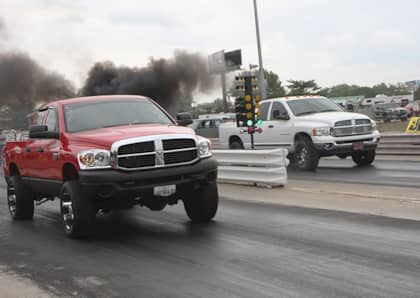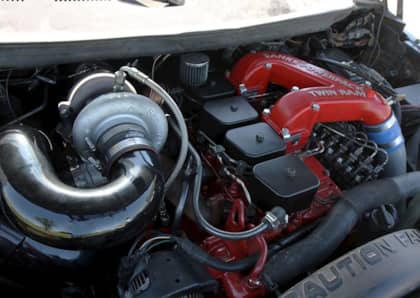How to Get 3,000 hp From 391 Cubic Inches: The Cummins Way
If you want to find out just how extreme you can build a Cummins diesel engine, then look no further than competition sled pullers. Nowhere else will you find 390-cubic-inch engines churning out 3,000 horsepower.

That’s right — 3,000 horsepower from less than 400 cubic inches. Not only that, these fire-breathers are doing it fuel-only, and are lasting an entire season (40 to 50 hooks). Based around the B series Cummins — the small block of the diesel pickup world — exotic parts like billet blocks, worked over cylinder heads, mega-sized turbochargers, and torrents of fuel are employed to transform a once tame, commercial-grade inline-six into a 6,000-rpm screamer that sees 150 pounds of boost.
The technology found in these engines is extensive, and what’s even more profound is that it all happened very quickly. Just seven or eight years ago, 1,900 hp was the big number to beat in the top ranks of the compound turbo Super Stock diesel truck class (i.e., the baddest of the bad). Now, that number is being made by the Pro Stock class — the single turbo category below it. Here, we look at some of the key breakthroughs that have pushed the Cummins B series into new territory.
Super B

One of the biggest names when it comes to transforming the B series Cummins into a 3,000 hp monster is Haisley Machine. After suffering from hard luck for years, the Haisley’s engine program made a complete 180-degree roughly five years ago, after they began building what’s referred to as the company’s “Super B” Cummins. It’s based off the 6.7L Cummins block, due to its Siamese cylinder bores providing superior strength over the 5.9L design. A bedplate is integrated for bottom end rigidity, the cylinders are sleeved, and a steel deck plate adds strength to the top of the block. The Super B engine shown here is what powers the “Alter Ego” Super Stock truck, owned by Matt Clemons.
The Scheid Solution

Scheid Diesel is the other big kid on the block when it comes to building mega horsepower Cummins mills. The long-time diesel performance specialist also offer a deck-plated 6.7L-based engine capable of withstanding nearly anything you can throw at it. These engines make between 1,500 and 3,000 horsepower (depending on the customer’s turbo, fuel system and other needs), hook to the sled 40 to 50 times per summer, and remain rock-solid reliable for the duration of a pulling season. With the goal to make engines ultra-reliable at this power level, more attention is paid to the finer details these days than ever before. Bearing clearances, cylinder clearances, how the valves are set, and cylinder head porting are all precisely executed for optimum reliability and power production.
Deck Plate

Here you can see the 1-inch steel deck plate Scheid uses in most of its high-end, 6.7L based Cummins builds. The primary purpose of the deck plate is to limit cylinder bore distortion, which can become worrisome in an engine with a stroke as long as what the Cummins uses. Due to the cylinder sleeves taking away displacement via the cylinder bore, the deck plate also allows some cubes to be added back into the equation (via more stroke). This particular engine was built for the Pro Stock Diesel Truck Class, where rules dictate that only a single turbo (with a 3.6-inch compressor wheel inducer size) can be used, and makes roughly 1,850 hp.
Billet Block

While billet-steel blocks have been available since 2007, Scheid Diesel debuted the first billet-aluminum blocked Cummins just three years ago. Sourced through LSM Systems Engineering, it was originally utilized as a way of lightening up Scheid’s Cummins-powered dragster, which has since run as fast as 6.21 seconds at 225 mph in the quarter-mile. Similar to the cast-iron based engines, the billet-aluminum block gets sleeved and deck-plated as well, for optimum durability. It’s rumored that this block is currently withstanding power at or approaching 3,000 hp.
Head Games

Hamilton Cams’ 12-valve performance cylinder head was a game-changer of sorts when it was released back in 2011. In the upper echelon of diesel motorsports, improved head flow was the primary reason why engines that were stuck in the 1,200 hp to 1,300 hp range jumped up to 1,700 hp almost overnight. Of course, cam, turbo and injection system advancements were also part of the puzzle, but increased airflow making it into the engine was a huge piece of the pie. Although it was initially outlawed in most classes, its cast-iron makeup and stock-like appearance enticed a lot of pullers to run it anyway (sneaking it past the tech process at events). To be sure, thoroughly CNC ported, oversize valve equipped, factory based 12-valve cylinder heads provide comparable flow to the Hamilton head and are also run on countless competition engines.
Turbo Compounds

In the Super Stock segment, vehicles are limited to a two-stage turbocharger configuration, and many trucks run three turbos (two atmosphere units, with a smaller high-pressure unit getting things started). Two turbos can make the same power as three, but with three turbos in the mix (two of which acting as one giant atmospheric unit) it can actually be more cost-effective to run a triple-turbo setup. This is because with a two turbo configuration, big bucks have to be spent on an exotic atmosphere charger in order for it to both make and survive excessive boost, whereas two “more basic” turbos can be used as the atmosphere units and don’t have to work as hard in a triple setup. No matter the turbo configuration, trucks in the Super Stock class make between 120 to 150 psi of boost. We will note however, that back before engine builders had good head flow, 150-180 psi was the norm.
Fuel Supply

The Sigma injection pump offered through Columbus Diesel Supply is the cream of the crop for diesel injection pumps. The unit shown is a billet version of the Sigma with six 17mm plungers (by comparison, the stock ’94-’98 5.9L Cummins came with a 12mm pump). Dual plunger pumps (12 plungers vs. 6) have also been used (sourced from 12-cylinder Deutz engines), but with the output being so high from 16mm and 17mm single plunger pumps, it’s really not worth the effort to go with a 12-plunger unit anymore. Supply of fuel to the injection pump is typically handled via a gear-driven fuel pump (usually a DSR or Waterman unit) capable of flowing an insane 500 to 600 gallons per hour.
Piston Forging

Used in most of Scheid Diesel’s competition-ready Cummins engines are these Arias forged-aluminum pistons. The valve relieved pistons feature a custom fuel bowl design, proprietary coating, and can be had in different compression ratios. Ultra low compression ratio pistons (12:1 is the norm in big power applications) allow the turbo(s) to cram a larger amount of air volume into the cylinders.











